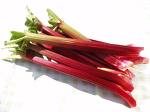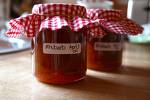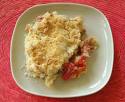USING SPRING FRUIT – RHUBARB
 Rhubarb is currently in season in Ireland so pop down to your local farmers market and pick up some. This unusual looking fruit grows well in the garden so get planting and enjoy your own personal crop. The part of rhubarb used in preparing food is the stalks. It is very versatile and can be made into the following: crumble, pie or jam. Here are a couple of tasty recipes to get you started.
Rhubarb is currently in season in Ireland so pop down to your local farmers market and pick up some. This unusual looking fruit grows well in the garden so get planting and enjoy your own personal crop. The part of rhubarb used in preparing food is the stalks. It is very versatile and can be made into the following: crumble, pie or jam. Here are a couple of tasty recipes to get you started.
Rhubarb and orange crumble.
450g rhubarb, cut into 2.5cm lengths
2 large oranges
75g sugar
For crumble
175g plain flour
75g butter or margarine
100g caster sugar
Method
- Heat oven to 180C/gas 4.
- Place the rhubarb, orange juice and rind and 75g sugar into a pie dish, mix, pre-cook in the oven if using garden rhubarb, for 10 mins. The shop bought is tenderer and would not need pre-cooking.
- Rub the butter or margarine into the flour, add the sugar and a little cinnamon if liked. Sprinkle the crumbs over the fruit.
- Bake in the centre of the oven for 35-40 minutes, the topping should be golden brown.
- Serve with custard or cream. Enjoy!
Rhubarb Jam.
450g rhubarb 
450g sugar
100g seedless raisins
1 tsp grated lemon rind
1 tsp grated orange rind
1 tablespoon orange juice
2 tablespoons lemon juice
Method
- Cut the rhubarb into 1cm pieces, sprinkle with the sugar and leave for 6 hours.
- Put into a large saucepan. Add the raisins, fruit rinds and orange juice.
- Stir over a low heat until the sugar is dissolved, then add the lemon juice and boil steadily until setting point is reached. If you are using a sugar thermometer the temperature should be 105C/222F.
- Allow to cool slightly, stir well, spoon into sterilised jars. Cool and label before storing.


